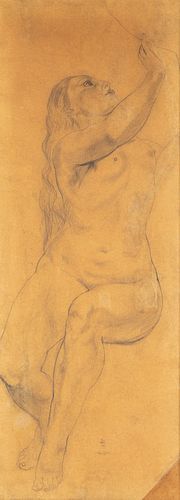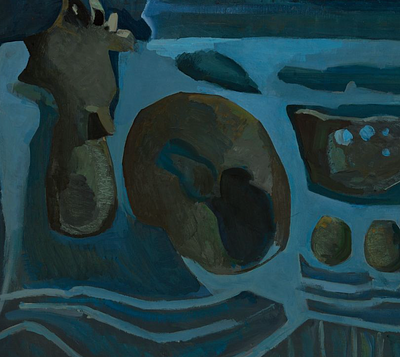LÉONARD TSUGUHARU FOUJITA (Tokyo, 1886 - Zurich, 1968). "Femme nue assise, tete et bras droite levée", 1924. Preparatory drawing for the canvas "L'Ami
Lot 81
About Seller
Setdart Auction House
Carrer Aragó 346
Barcelona
Spain
Setdart Subastas was born in 2004 and is currently the first online art auction in Spain with solidity, prestige and reliability guaranteed by our more than 60,000 users. Setdart has a young, dynamic and enterprising team ready to successfully manage the purchase and sale of art works through custom...Read more
Categories
Estimate:
EUR€50,000 - EUR€60,000
$53,191.49 - $63,829.79
Absentee vs Live bid
Two ways to bid:
- Leave a max absentee bid and the platform will bid on your behalf up to your maximum bid during the live auction.
- Bid live during the auction and your bids will be submitted real-time to the auctioneer.
Bid Increments
| Price | Bid Increment |
|---|---|
| EUR€0 | EUR€10 |
| EUR€200 | EUR€25 |
| EUR€500 | EUR€50 |
| EUR€1,000 | EUR€100 |
| EUR€3,000 | EUR€200 |
| EUR€5,000 | EUR€500 |
| EUR€10,000 | EUR€1,000 |
| EUR€20,000 | EUR€2,000 |
| EUR€50,000 | EUR€5,000 |
About Auction
By Setdart Auction House
Jul 27, 2021
Set Reminder
2021-07-27 08:00:00
2021-07-27 08:00:00
America/New_York
Bidsquare
Bidsquare : CONTEMPORARY AND ACTUAL ART
https://www.bidsquare.com/auctions/setdart-auction-house/contemporary-and-actual-art-7261
Setdart Auction House sofia@setdart.com
Setdart Auction House sofia@setdart.com
- Lot Description
LÉONARD TSUGUHARU FOUJITA (Tokyo, 1886 - Zurich, 1968). "Femme nue assise, tete et bras droite levée", 1924. Preparatory drawing for the canvas "L'Amitié". Graphite on paper adhered to canvas. Attached certificate issued by Sylvie Buillon. Size: 130 x 48 cm; 136 x 57 cm (frame). The canvas "L'amitié", for which our drawing is a preparatory sketch, was bought by the French state from Léonard Foujita himself in 1926. Currently kept at the Centre Pompidou in Paris under inventory number JP387P, the final canvas depicts two young girls with a strong symbolist heritage, worked through a stylized silhouette of shadows and simplified reliefs. Specifically, our drawing depicts the young woman in "L'amitié" in a seated position, raising her right arm high, bringing it closer to her companion. Like other drawings by Foujita, the modeling is very light, but it is enough to give weight and volume to the figure. Born Tsuguharu Foujita, he was a Japanese painter who became a naturalized French citizen. Linked to the School of Paris, he developed a very personal style, and was receptive to various influences, such as Gauguin and the symbolists. His art is characterized by the valuation of line over volume, leaving aside illusionism. He works with stylized silhouettes, shadows and simplified reliefs. After studying at the National University of Fine Arts in Tokyo, Foujita moved to Paris in 1913. Four years later he organized his first solo exhibition in that city, and from 1919 he repeated his presence at the Salon d'Automne. In 1924 he was appointed a member of the Tokyo Academy of Fine Arts, although he did not visit his country again until five years later, with a very successful exhibition. He travels the American continent between 1931 and 1933, and then settles in Japan, where he makes several commissioned murals. He returned to Paris in 1939, but lived most of World War II in his country. After a stay in the United States, Foujita moved back to Paris in 1950. He adopted the French nationality, and in 1959 he converted to Catholicism, being baptized with the name of Léonard. Foujita brought to the avant-garde School of Paris the refinement and subtlety of traditional Japanese art and Chinese ink. His portraits, nudes and landscapes bridged the gap between Eastern tradition and Western modernity, as evidenced by the hundred or so works that made up the first anthological exhibition in Spain of the Franco-Japanese artist, held in 2005 at the Bancaixa Cultural Center in Valencia. In the artist's own words: "my body grew up in Japan and my work in France. I have my family in Japan and my friends in France. Now I have become a cosmopolitan of two homelands". Of refined education and exquisite courtesy, with an attractive and elegant appearance, Foujita and the subtlety of his stroke aroused the admiration of the artists of the bohemian district of Paris, Montparnasse, who immediately welcomed him into their midst. He never abandoned figuration, reinterpreted the classic genres of portrait, nude and landscape, and immersed himself in the atmosphere of those "crazy years" having as bohemian companions Picasso, Modigliani, Chagall or Soutine. He thus began a new vital and artistic stage, after having won numerous prizes in exhibitions in Tokyo, having sold a work to the Japanese emperor and having been called to portray the emperor of Korea. His work is present in the National Museums of Modern Art in Paris, Kyoto and Tokyo, the Petit Palais in Geneva, the Fine Arts Museums of Buenos Aires, San Francisco, Boston and Harvard University, and the Thyssen-Bornemisza Museum, among many others.
- Shipping Info
-
In-house shipping available. Please inquire at admin@setdart.com.
-
- Buyer's Premium



 EUR
EUR CAD
CAD AUD
AUD GBP
GBP MXN
MXN HKD
HKD CNY
CNY MYR
MYR SEK
SEK SGD
SGD CHF
CHF THB
THB
















